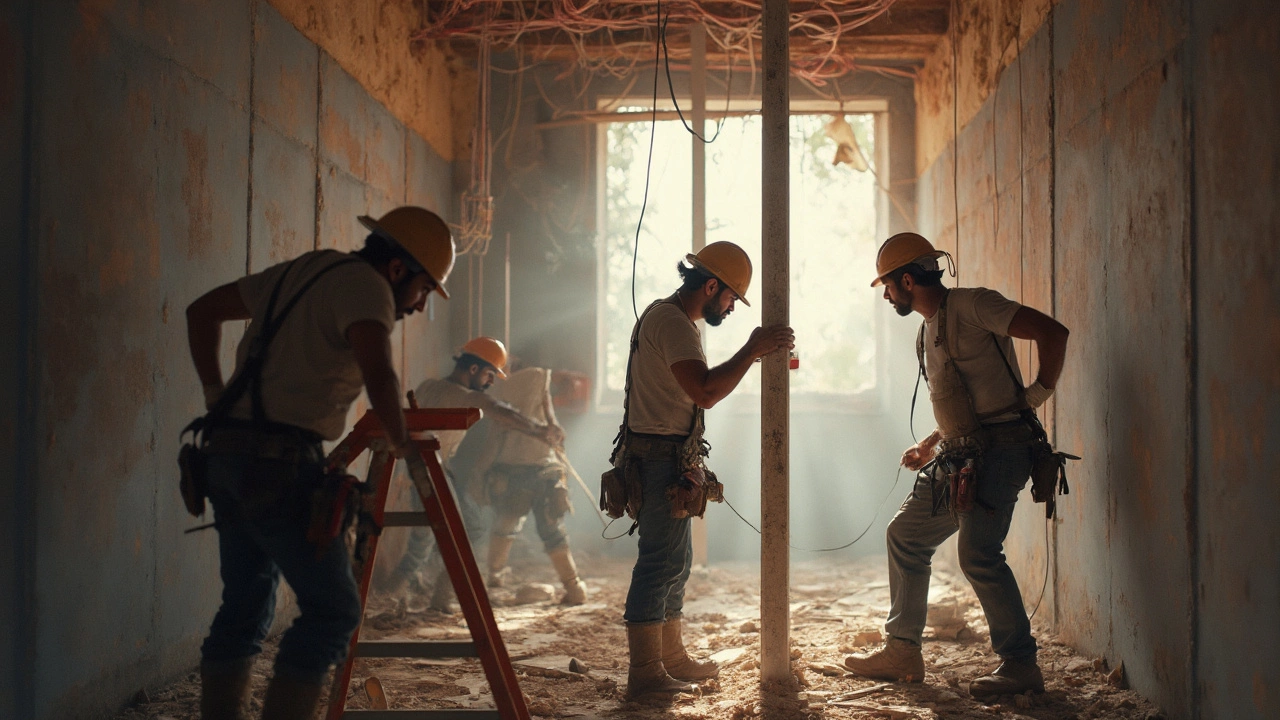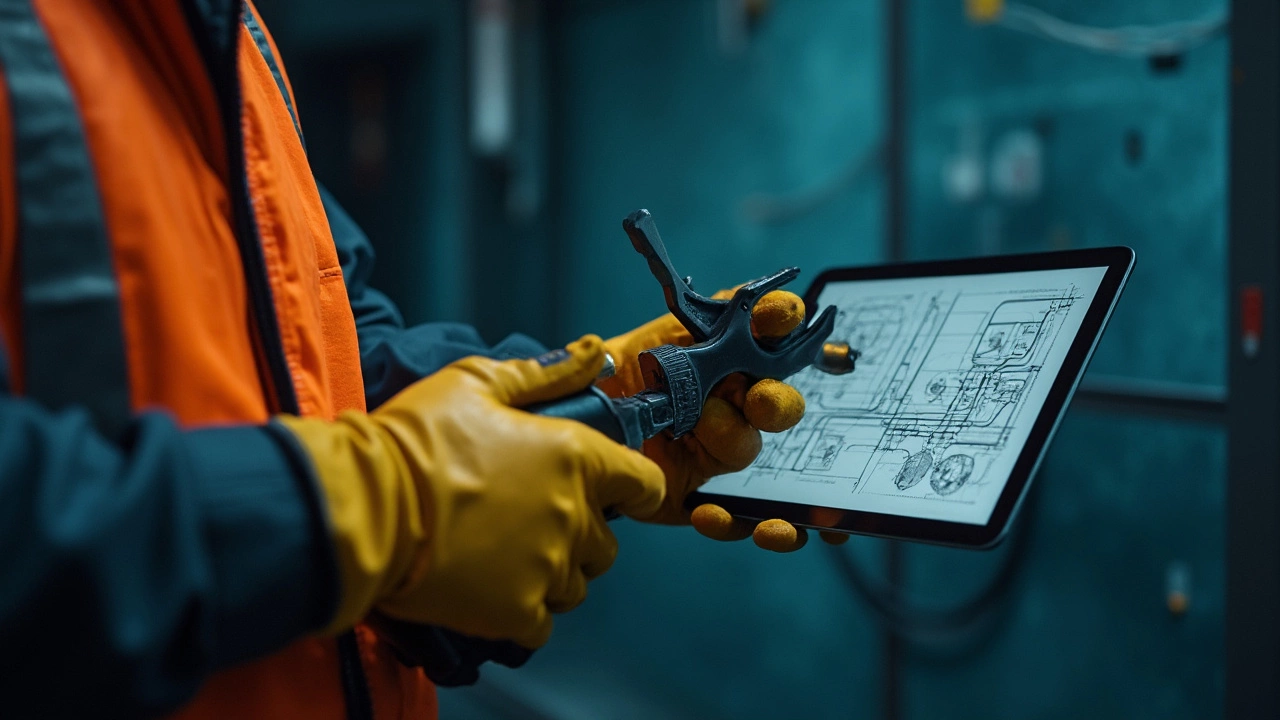
If you’re eyeballing a career as an electrician, you’re probably wondering if the work beats up your body. I used to think wiring houses was just about clever problem-solving, but boy, there’s a lot of physical stuff nobody talks about—until you’re in it.
Electricians don’t spend their days sitting at a desk. You’re up on ladders, crawling into weird spaces, hauling cable, and holding your arms overhead way longer than feels natural. There’s a reason folks joke about an “electrician’s squat”—you end up crouched on your haunches for half an hour trying to run wire behind a wall. Knees, shoulders, and your back all get a workout. But here’s the thing—knowing what your body’s in for lets you get ready, work smarter, and dodge a lot of aches down the road.
- What Physical Tasks Do Electricians Really Do?
- Tough on the Back, Knees, and Shoulders
- Injuries and Common Health Issues
- Staying Safe: Tools, Gear, and Habits
- Keeping Your Body in Good Shape
- How the Job Looks Today (And In The Future)
What Physical Tasks Do Electricians Really Do?
When you first think of an electrician, you might picture someone just twisting a few wires and flipping breakers. Reality check: this job is about way more than that. Most electrician training covers the mental stuff—blueprints, codes, circuits—but the physical work is what you feel at the end of the day.
Here’s what’s really on your plate if you’re doing this for a living:
- Crawling and Climbing: You’ll shimmy through attics, crawlspaces, and under houses. Ladders are your constant companion, whether you’re hanging light fixtures or running conduit up a wall.
- Bending, Squatting, and Kneeling: Running wire behind walls or in ceilings? Hope your knee joints are friendly. You’ll crouch, duck, and even lie stomach-down on floors to get things done.
- Lifting and Carrying: Cable reels, heavy toolkits, metal conduit, and junction boxes add up in weight. Sometimes you’re schlepping thirty pounds (or more) up a few flights of stairs.
- Repetitive Tasks: Cutting, stripping, and connecting wire isn’t glamorous after eight hours straight. Arms, wrists, and hands start to feel all that twisting and tugging.
- Working Overhead: Installing light panels, ceiling fans, and running conduit overhead isn’t a quick job. Your shoulders and neck start to ache if you’re not careful.
- Tight Spaces: Picture squeezing into a two-foot crawlspace or unlocking a fuse box surrounded by storage. Some days you feel more like a contortionist than an electrician.
This stuff isn’t just theory, either. According to the U.S. Bureau of Labor Statistics, electricians spent about 40% of their time on tasks that involved bending, kneeling, or working overhead as of 2023. You’re almost always on the move.
| Common Physical Task | Average Frequency (per week) |
|---|---|
| Climbing ladders | 15-25 times |
| Crawling/tight spaces | 10-15 times |
| Lifting objects over 25 lbs | 8-12 times |
| Working overhead | 20+ hours |
So, if you’re looking at this trade, add “staying in shape” to your toolbox. The more you pay attention to form, habits, and good job safety practices, the easier this physical grind gets.
Tough on the Back, Knees, and Shoulders
People don’t always realize how much strain electrician training puts on the main parts of your body. You’re not just fiddling with wires—half the job is squeezing into tight spaces, lifting heavy stuff, or spending ages on a ladder. Your back, knees, and shoulders end up doing the heavy lifting—literally and figuratively.
Let’s break it down. Your back pays the price for running cable in crawl spaces, loading supplies, or leaning over awkwardly for hours to reach a tricky panel. Kneeling on hard surfaces is part of the daily grind, especially when working in unfinished homes or on commercial jobs. If you’re not careful, this kind of wear and tear adds up. The shoulders don’t get off easy either—think about holding a drill above your head to open up a ceiling, or pulling thick wire across long distances overhead. That repetitive overhead movement can lead to aches or even injuries that just stick around if you ignore them.
Ever heard of "electrician's knee" or "frozen shoulder"? These aren’t just stories—they’re problems that hit a lot of people in the trade. Kneepads and padded mats help, but you need to use them every time, not just when things get uncomfortable. As for your back, using lifting straps, working with a partner, or even just taking a minute to stretch on-site can make a noticeable difference.
Here’s a quick look at what the job can do to your body if you skip the good habits:
| Body Part | Common Issues | Simple Fixes/Preventative Steps |
|---|---|---|
| Back | Strains, herniated discs | Lift with knees, stretch, team lifts |
| Knees | Bursitis, pain, swelling | Kneepads, frequent breaks, change position often |
| Shoulders | Rotator cuff strains, frozen shoulder | Limit overhead work, use tools with extensions, rest arms |
Job safety and health don’t just happen by chance. If you’re planning on being in electrician training or the field long-term, get serious about your body mechanics right away. Even the little things, like using the right tools or switching up your routine, save you a load of pain and help you last in the trade.
Injuries and Common Health Issues
Being an electrician means you have to think about more than just getting zapped—though yes, electrical shocks are part of the risks. Let’s get real for a second: most injuries aren’t as dramatic as the movies would have you think. Strained muscles and sore joints are far more common than someone lighting up like a cartoon.
Back problems top the list, and it’s easy to see why. Bending, lifting, and carrying reels of cable or ladders all day makes for a cranky lower back by the time you hit your 30s. Elbows and shoulders get beat up from holding tools overhead, especially when you’re tightening connections for hours in ceilings. Knees take a hit too, since a lot of wiring work means kneeling or crouching on hard floors.
Cuts and scrapes aren’t rare—think about working in attics full of nails or squeezing behind sharp-edged panels. If you slip up with a utility knife or a fastener, you’ll know right away. Then there’s repetitive strain from using hand tools all day. People talk about ‘electrician’s wrist’ because twisting screwdrivers and stripping wires adds up.
And yes, the electrical side is there. While training is all about safety drills, accidental shocks do happen when someone skips a step or a wire wasn’t marked right. Most are mild, but every electrician I know has felt that jolt at least once.
- Back, neck, and shoulder strain from lifting, awkward positions, and long stretches of working overhead
- Knee pain from kneeling or squatting for long periods
- Cuts, scrapes, and punctures from sharp tools and building materials
- Repetitive strain injuries in the hands and wrists
- Electrical shocks, mostly minor but sometimes more serious
Just to put a number to it, according to the U.S. Bureau of Labor Statistics, non-fatal injuries for electricians (like strains and sprains) hover around 135 out of 10,000 workers in a year. That’s higher than the average for all jobs.
The good news is, knowing the hotspots can help you do something about them. Later on, I’ll get into how to dodge these injuries, but if you’re training as an electrician, keep your eyes open for warning signs in your own body. Soreness isn’t just part of the job—it’s usually telling you something important.

Staying Safe: Tools, Gear, and Habits
Being an electrician isn’t just about getting the job done—it’s about making it home in one piece. Safety isn’t just common sense, it’s a lifestyle. From the first day of electrician training, instructors hammer home the basics: the right tools, proper gear, and steady habits keep you out of trouble.
First up, gear matters. You’ll see experienced electricians with thick rubber-soled boots, insulated gloves, and safety glasses. No one skips this stuff, especially on commercial sites. Hard hats save lives from falling debris, and knee pads save your joints in the long run. You can spot the new guys by their shiny unused gear; the seasoned pros depend on it every day.
Let’s talk tools. Using insulated hand tools is key—even a casual slip can make a simple job dangerous if you’re around live wires. Cordless drills have taken a lot of strain off arms and wrists, but don’t cheap out on quality; busted tools mean injuries. Labeling wires and keeping a tidy work area might not sound flashy, but trust me, it keeps accidents to a minimum.
Here’s a quick checklist most electricians swear by:
- Test for power—always double check before working on any circuit.
- Keep your hands dry to avoid shocks.
- Never wear metal jewelry, even a wedding ring, while working with electricity.
- Hydrate and take breaks—fatigue causes mistakes.
- Store tools properly so you’re not tripping over them.
If you’re wondering what injuries are most common, one insurance survey found that about 35% of electrician injuries are from falls and about 25% are from working with live electricity. Getting in the habit of using the right job safety practices can put you ahead of the stats.
Some folks use apps for organizing jobs or checking codes, but good old habits—like never being in a hurry and double-checking your work—are still gold. The guys who stay safest and healthiest aren’t usually the biggest or toughest. They’re just the ones who pay attention, wear their gear, and use the proper electrician health tricks without skipping steps. If you’re new, latch onto a veteran who does it right and copy them.
Keeping Your Body in Good Shape
Staying healthy as an electrician comes down to a mix of good habits, smart planning, and listening to your body. The physical side of the job doesn’t have to wreck you. You just need the right approach. Let’s look at what works in the real world.
Start with warming up—yeah, it sounds cheesy, but stretching your legs, back, and shoulders before a long day of electrician training or work actually keeps you loose. A lot of old-timers I know wish they’d started doing this from day one.
Keeping fit outside the job isn’t just bonus points—it makes a difference on site. Strength training a couple times a week helps handle heavy lifts. Add some light cardio, like brisk walking or cycling. You don’t have to be Arnold, but strong legs and a steady core save your back a ton of trouble.
- Use knee pads when you’re on hard floors. Those thin work pants won’t do much—you’ll thank yourself after a week rewiring kitchens.
- Switch up your stance and swap hands when possible. Always reaching, twisting, or using the same side wears you down faster.
- Stay hydrated and snack smart. Dehydration and sugar crashes hit harder than you’d think when crawling attics in the summer.
- Mix up tricky tasks instead of marathoning one thing. For example, don’t spend three hours straight crouched under a stairwell. Stand up, stretch, and rotate to a new position at least every half hour.
The right tools make a massive difference. Lightweight, ergonomic handles keep hands and wrists from splitting after years of repetition. When possible, let the power tool take the strain—don’t muscle everything by hand if you’ve got a cordless driver handy.
Don’t skip on support gear. Back braces, braces for the wrist, and quality work boots with strong arches fight off some of the most common health issues in the electrician training field. A survey by the National Safety Council found that regular use of basic protective gear can cut workplace injury claims by over 40%.
| Common Problem | Preventive Gear/Tip |
|---|---|
| Knee pain | Knee pads, frequent standing breaks |
| Back strain | Back brace, proper lifting technique |
| Hand/wrist issues | Ergonomic handles, hand stretches |
| Foot fatigue | Supportive boots, insoles |
If you have old injuries (I blew out my shoulder years ago), regular check-ins with a physio save a world of hurt. They’ll give stretches and little tweaks specific to the electrician physical demands you’re facing. Nalini once had to remind me for weeks to book an appointment—worth every nag.
Bottom line, you don’t need to be superhuman. You just have to work thoughtful and not try to be a hero every single job. The habits you build early pay off big time later, and your body will stick with you—if you stick with the basics.
How the Job Looks Today (And In The Future)
If you’re thinking electricians still do everything by hand, hanging from rafters with nothing but grit and a screwdriver, that’s old news. Electrician training in 2025 is way smarter than it used to be. Today, cordless tools, laser levels, and wire pulling machines are everywhere, saving your back and shoulders a ton of stress. Don’t forget those jobsite apps that track projects and let you look up diagrams without shuffling through stacks of paper.
The physical grind is still there, but safety and efficiency have jumped way up. The National Safety Council noted that on-site electrical injury rates dropped by around 30% over the past decade, partly thanks to better protective gear and smarter worksite planning. Companies are getting more serious about ergonomics too, so it’s more common to see padded kneepads, anti-vibration gloves, and adjustable harnesses issued as standard gear.
Looking at the future, electrician physical demands keep evolving. More big buildings are getting smart systems—think automated lighting or complex security setups—which means electricians spend more time programming and troubleshooting than dragging cable. There’s a growing need for folks who get both physical installs and digital controls. That doesn’t mean the job’s gone soft, but tech is cutting down on the worst wear and tear.
Here’s what’s changing or coming soon:
- Robotics—Some sites now use robots to snake cable through long runs. Not everywhere yet, but slowly catching on.
- Augmented reality goggles—These are popping up for complex jobs, so you can see plans overlaid on actual walls. It cuts down on mistakes and time spent in awkward positions.
- New materials—Wires and cables are getting lighter, and connectors are designed for faster, easier installs.
- Work-life balance focus—Contractors and unions are pushing for shorter shifts or assigned rest periods, since there’s proof it means fewer injuries and happier workers.
There’s still real labor involved, but if you’re tech-savvy, you’ll have more ways to do the tough stuff without wrecking your body. Smart habits plus new gear can help you last longer and stay healthier in this trade. Keep up with the trends, and you’ll be working smarter, not just harder.
